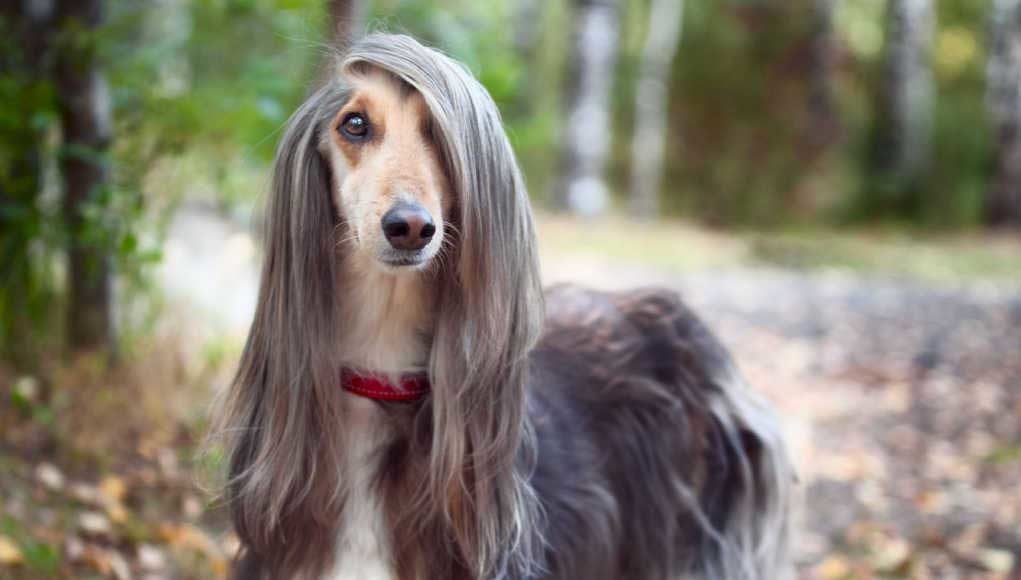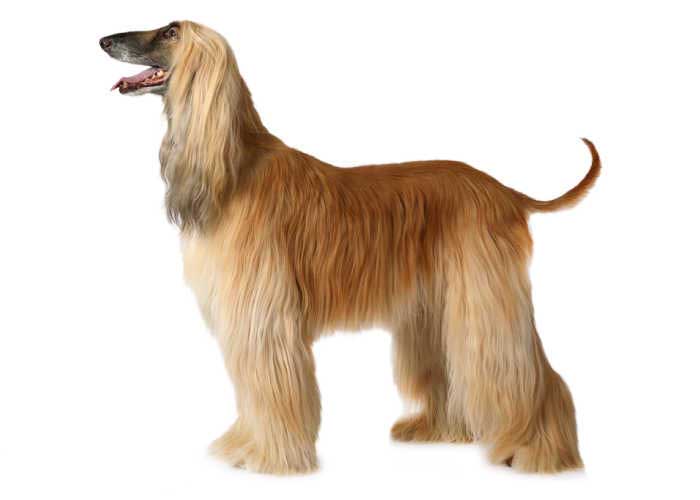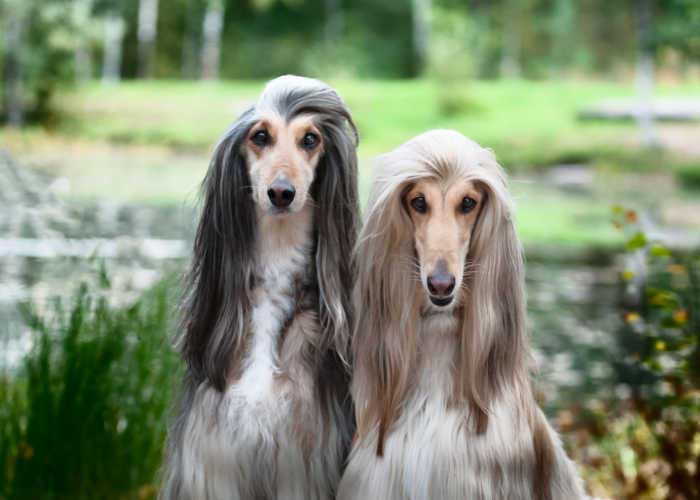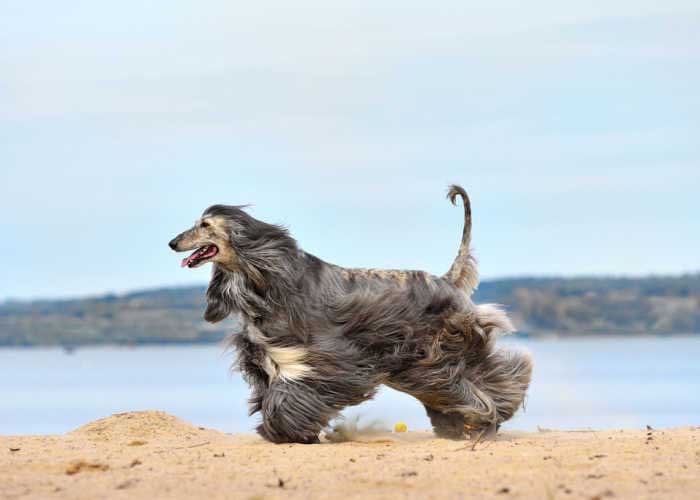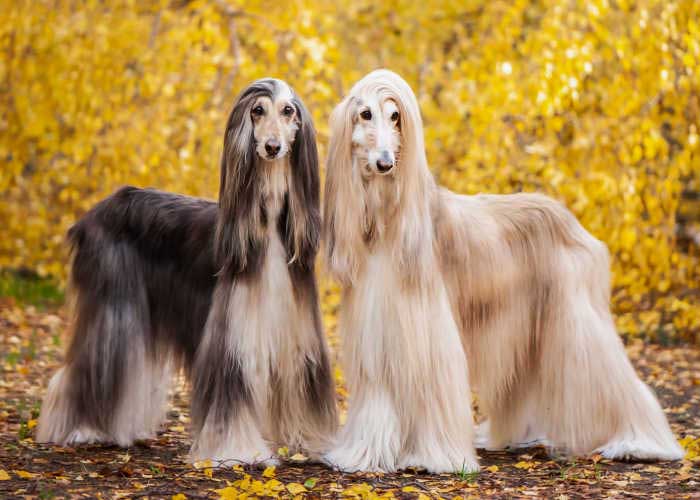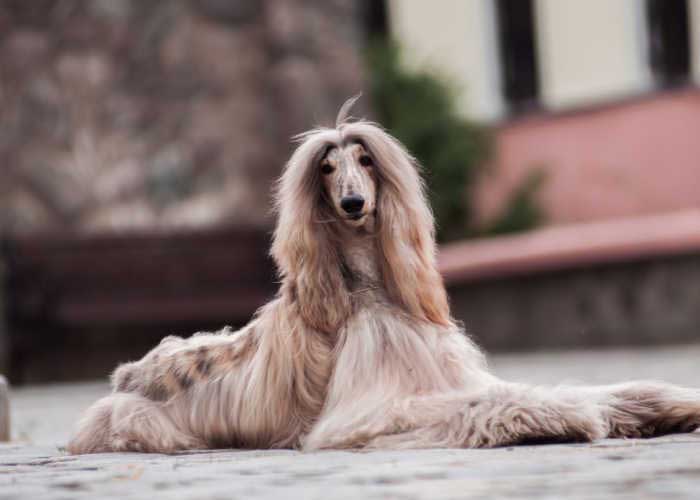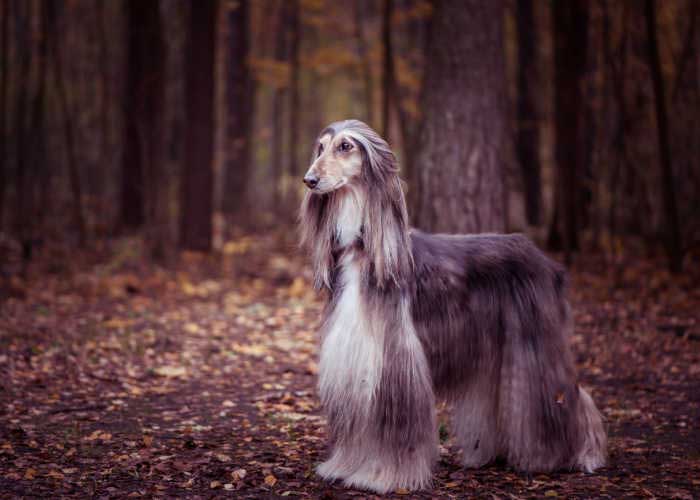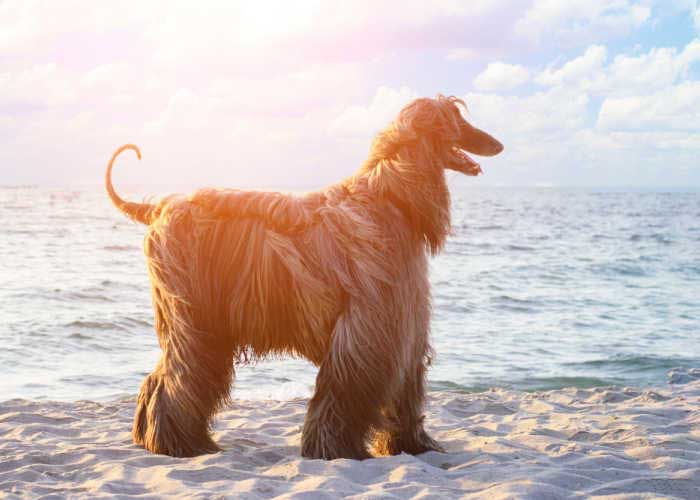Table of Contents
The Afghan Hound dog breed is a dignified aristocrat of exquisite beauty. Learn more about living with this hound breed!
A dog of graceful elegance, the Afghan Hound is a rare, ancient breed with a look quite unlike any other. Despite the regal appearance, enthusiasts describe it as aloof and amusing.
This breed, which was formerly known by the name Tazi, is one of the oldest canine breeds and is believed to have existed before Christianity.
Originally bred for hunting large prey in Afghanistan's highlands and deserts, the Afghan Hound dog was highly valued for its ability to sprint quickly and far.
It can bravely contain deadly animals like leopards until its huntsman on a horse caught up.
It was also prized for its capability to think and hunt independently without human guidance.
The thick, silky, flowing coat wasn't only for show as it also protects the Afghan Hound breed from the harsh conditions in the mountainous areas where it first made its living.
Today, this dog enjoys life as a playful family companion and a natural for a sport called lure coursing.
In 1926, the American Kennel Club recognized the breed. It ranked 114th on AKC’s list of the most popular dog breeds of 2021.
Afghan Hound Dog Breed Standard
Height and Weight
This breed grows up to 25 to 27 inches and weighs between 50 to 60 pounds.
Coat
When maintained properly, the coat is magnificent. It has a very fine texture that is thick and silky resembling human hair.
Every part of the body, including the ears and feet, is heavily covered in hair, except the back.
The coat can be black, black-and-tan, red, cream, blue, brindle, domino, or white.
Features
Underneath the glamorous façade is a strong, agile hound created for a full day of hunting.
Its enormous paw pads served as shock absorbers on the harsh terrain of its native land.
Afghan Hound Family Life
Like puppies of any breed, an Afghan puppy will enthusiastically seek attention from family members.
As it matures, the Afghan Hound will no longer lavish attention on anyone, and sometimes doesn't even want to be petted or cuddled.
With the independent nature still present in this sighthound, it will decide for itself about when it wants affection, on its terms and not yours.
Despite the disinterest, the Afghan Hound dog can be highly entertaining and tender when it wants to be.
It is known to be mischievous that is frequently referred to as a “clown” by its loving family.
This breed is affectionate and versatile, thriving in practically every environment and family size.
However, keeping that expensive coat will take a lot of your time, and you'll also need to work out frequently to keep up with its high energy levels.
If you can provide them the care they require, you'll have a devoted friend who will undoubtedly draw attention to themselves with their stunning appearance.
The Afghan Hound breed may get along with both kids and other pets with the right training and attention from the owner.
But unsurprisingly, its urge to hunt leads it to chase small animals, especially if they run away.
Although this breed is usually good and even loving with children, it is best if the puppy grows up with kids that are old enough to understand the value of being mindful of this dog's sensitive nature.
Like all breeds, no matter the size, always teach children how to treat dogs.
The Afghan Hound dog breed can be a great buddy but no matter how friendly, you should never leave it all by itself with a child.
Afghan Hound Dog History
These dogs are quite old breeds.
In fact, according to some authorities, they are the oldest purebred dogs. An ancient myth claims that a brace of Afghan Hounds represented the canine species on Noah's Ark.
Because they were developed in some of the world's most remote regions, their precise time and place of origin within the vast area that is now Afghanistan, India, and Pakistan will never be known.
What is known is that these breeds have long served as prestige symbols for nobles, tribal leaders, and royalty in Asia's mountain kingdoms.
They are tough, agile hunters who use their keen eyesight and quick reflexes to locate and hunt prey.
Afghan Hound dogs have been part of Eastern culture since the beginning of civilization, but it wasn't until the late 1800s that they entered Western history.
At that time, Afghan Hound breeds were brought to Europe by English officers who had just returned from the furthest reaches of the British Empire.
They were the breed of choice among the British nobles around the turn of the 20th century.
The AKC recognized the first of the breed in 1927, but it wasn't until the early 1930s that American breeders and owners began to take an interest in them.
A breeding pair of dogs brought over from England by Zeppo Marx, the youngest of the eccentric Marx Brothers, was among the most significant canines of those early years in America.
Since then, their fame in America has been cultivated thanks to their admirable traits as a pet and commanding presence in the ring.
The enormous Pablo Picasso artwork in Chicago's Daley Plaza shows Kabul, the beloved Afghan Hound of the artist.
Afghan Hound Breed Health
Although typically a healthy breed, Afghan Hound dog breeds can experience various health issues, such as cancer, juvenile cataracts, and hypothyroidism.
The Afghan Hound can develop bloat, which is a sudden and potentially fatal swelling of the abdomen, like other deep-chested breeds of dogs.
Thus, owners should familiarize themselves with its signs and what to do should bloat occur.
It is recommended that all breeding dogs have their eyes certified through an OFA eye exam before breeding, thyroid evaluation, and hip assessment to confirm that everything is normal.
Your furry friend may also be susceptible to allergies brought on by the environment, food, and other particular substances.
The Afghan Hound dog and other sighthounds have naturally low body fat levels, making them sensitive to anesthesia.
While shielding every dog from inherited issues is impossible, the danger can be reduced with the right treatment.
The majority of Afghan dogs live healthy lives, often until the ages of 12 to 18.
RELATED: Cataracts in Dogs
How to Care for Afghan Hounds
Exercise
An Afghan Hound breed needs a lot of activity to prevent boredom and destructive tendencies like chewing, even though it makes excellent apartment dogs and true “couch potatoes.”
This pooch needs to walk for at least a mile or two every day, and a fenced-in yard is necessary for running.
The Afghan Hound dog breed is a sighthound, designed to hunt and pursue prey by sight, hence going off-leash is not advised because it will have a strong tendency to dash off in search of perceived prey.
It is infamous for disobeying calls to come, and tragic car accidents happen frequently.
Therefore, you should never allow it to roam around unattended as its predatory instincts may endanger nearby pets.
Training
Afghan Hounds are often independent and aloof, but once they develop a bond with someone, they become very affectionate and devoted.
Because of this loyalty, you may find it challenging to settle these dogs into their new families.
On the other hand, because they desire to please their owners, it can make them simple to housetrain.
Teaching fundamental commands like come, sit, and stay is usually adequate unless obedience or agility competition is the goal.
These dogs may often show their stubbornness and are extremely sensitive to harsh correction, which frequently results in disobedience.
Owners of Afghan Hound breeds are frequently the first to point out that no amount of training will be able to suppress the breed's innate desire to run off in a high-speed pursuit.
So, be firm yet gentle with your discipline and guidance for them to respond well.
Due to their independence, training can take a while, therefore patience is needed.
Grooming
The long, silky coat of adult Afghan Hound dog breeds needs regular grooming. To keep the hair free of tangles and to get rid of any debris, several hours of brushing per week are required.
The magnificent coat looks its best when the hair is kept clean and clear of mats. It's also necessary to take regular baths with shampoo and conditioner.
Trim the nails every once in a while, as long as the nails don't grow too long to the point where you can hear them clicking on the floor.
Check the ears for signs of infection. You may want to wipe them out to spot potential problems.
Brush the teeth daily to improve general health and breath.
Diet and Nutrition
The Afghan Hound should thrive on premium dog food, whether it is produced commercially or made at home under the guidance and consent of your veterinarian.
This breed is naturally lean since it is a sighthound, and its protruding hipbones constitute a distinctive breed trait rather than an indication that it is underweight.
Being sporty and active, an Afghan Hound dog should receive adequate healthy nutrition to suit its needs.
Some consume much less than their stature may indicate, and they are incredibly skinny behind their thick coats.
A high-quality dog food, perhaps enhanced with vegetable oil, can aid in maintaining healthy hair and skin.
To choose a balanced diet, speak with your veterinarian to determine meal portions and suitable dog food based on your dog's age, weight, and activity level.
Fresh, clean water should always be accessible.
Ideal Owner of Afghan Hound Dogs
The Afghan Hound breed is best suited as an adult companion due to its independence and size.
It is unlikely to desire to play with kids and follow them around. In fact, it can be startled by a child's brisk movements and volume of noise.
As a result of its high maintenance and training requirements, this breed is frequently discouraged by new dog owners.
It has a more aloof disposition, which is contrary to what most new dog owners desire in their puppies.
In fact, due to its independent and somewhat distant nature, this dog is frequently described as cat-like.
FAQs about Afghan Hound Breeds
Does the Afghan Hound dog breed bark a lot?
While some dogs constantly bark, others are relatively calm.
Compared to most breeds, the Afghan Hound dog breed doesn’t bark much.
Can an Afghan Hound dog breed live in an apartment?
Even this enormous breed can be content to lounge and slumber in limited apartment quarters after you tire it out.
Like most other dogs, it can get too active and then destructive if left alone in a limited living space.
Is an Afghan Hound dog breed a good family pet?
Despite being calm and loving, this dog might not be the best choice for younger children because it is too aloof and not interactive or lively enough for toddlers.
Younger kids might be curious and yank gleefully on the dog's long hair, which could overwhelm this enormous hound.
Afghan Hound Dog Breeds Summary
If you can keep up with the required serious grooming routine, Afghan Hounds could be the right canine companions for you!
Talk about glamorous, they certainly match that description.
And while they do require an active owner who enjoys spending time with their dog, these huge fluffballs don't demand the same kind of intense companionship that you'd get from a retriever or a working dog.
With the right leadership, they can even turn out to be lovable and accustomed to living in a family with children.
So, are they the dogs that you desire?
People purchase Afghan Hound dogs without the ability to commit to the lifetime of these animals. If you want to bring a dog home, consider adopting one.
There are many Afghan Hound breeds in need of fostering.
Still, gather more information before getting a puppy to see compatibility with your lifestyle.
You may visit various breeders and see the dogs yourself. Find a reputable breeder who will show health clearances to prove that the dogs are clear of health conditions.
The Afghan Hound Club of America has been around since 1940 to protect and promote the breed.
Members in every state will be your point of contact if you are considering adding Afghan Hound dog breeds to your home.


